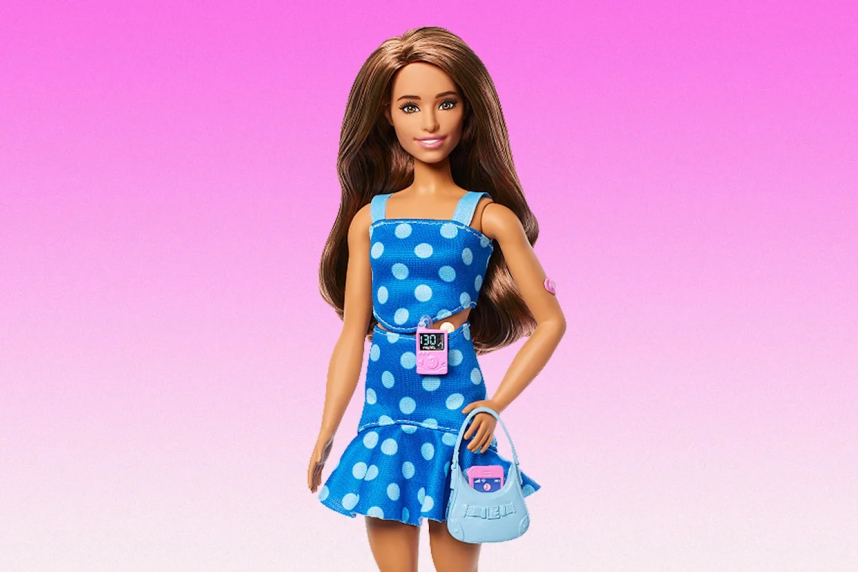
The new Barbie comes with an insulin pump, a glucose monitor, and snacks to help her manage her blood sugar levels.
The latest Barbie slays in a chic blue polka-dot crop top, ruffled miniskirt, chunky heels, and an insulin pump. The polka dots on Barbie's outfit are a nod to colors and symbols for diabetes awareness. She is the brand’s first doll with type 1 diabetes.
Dollmaker Mattel collaborated with Breakthrough T1D, formerly known as the Juvenile Diabetes Research Foundation, to design the doll, which aims to represent the approximately 304,000 kids and teens living with type 1 diabetes in the United States.
The doll launched Tuesday (8/7/2025) at the Breakthrough T1D Children’s Congress, a three-day event in Washington that brings in kids and teens living with the condition to meet with lawmakers. This year, they’re asking Congress to renew funding for the Special Diabetes Program, which was first allocated by Congress in 1997. The program’s current funding ends after September.
The advocacy efforts have taken on new urgency this year. With so many deep cuts to federally funded projects in recent months, Breakthrough T1D said it’s anxiously watching to see if this funding will be reupped.
Type 1 diabetes is typically diagnosed in childhood, but it can be diagnosed in anyone at any age. It differs from type 2 diabetes, in which people are still able to make insulin, but their cells stop responding to it.
In addition to the insulin pump that attaches to the new Barbie’s waist, the chestnut-haired beauty has a continuous glucose monitor on her arm – a button held on by a strip of heart-shaped Barbie-pink tape. Her cell phone displays an app that shows her glucose readings. She also has a light blue purse to hold her supplies and snacks to help her manage her blood sugar throughout the day. It matches her shoes, of course.
Emily Mazreku, director of marketing and communications at Breakthrough T1D, lives with type 1 diabetes and worked with Mattel to design the doll. Barbie’s phone app displays a snapshot of her actual blood sugar readings from one day during the design process. Barbie’s blood glucose reading is 130 milligrams of sugar per deciliter of blood, which is in the normal range. Most people with diabetes try to keep their blood sugar between 70 and 180 mg/dl. Her continuous glucose monitor has a graph that shows the highs and lows that can happen during the day. The blue polka dots are nods to the colors and symbols for diabetes awareness.
The line has dolls with more than 175 different looks, including a variety of skin tones, eye and hair colors. It includes a Barbie with behind-the-ear hearing aids, a blind doll who uses a cane, and another with a prosthetic leg. There’s also a doll with vitiligo, a condition in which skin loses its pigment and becomes splotchy.
“We know that increasing the number of people who can see themselves in Barbie continues to resonate,” said Devin Duff, a spokesperson for Mattel, in an email to CNN.
The company said the blind Barbie and a doll with Down syndrome were among the most popular Fashionista dolls globally in 2024.
The company launched its first doll with a disability — a friend for Barbie called Share-a-smile Becky, who used a wheelchair — in 1997. Customers noted at the time that Becky’s wheelchair couldn’t fit through the doors of the Barbie Dream House, a situation many people with disabilities encounter in real life.
That insight is part of the value of having kids play with dolls that have disabilities, said Dr. Sian Jones, co-founder of the Toy Box Diversity Lab at Queen Margaret University in Edinburgh, Scotland.
Jones and her colleague, Dr. Clare Uytman, study how playing with dolls and toys with a range of physical challenges can reduce systemic inequality for disabled people.
Jones and her colleague, Dr. Clare Uytman, study how playing with dolls and toys with a range of physical challenges can reduce systemic inequality for disabled people.
It’s based on a theory of mirrors and windows by Rudine Sims Bishop, a professor emerita of education at Ohio State University. Bishop realized that having diverse characters in books was good for all kids: It helps children from minority groups see themselves mirrored in the lives of book characters, and it gives kids a window into the lives of others, helping them build empathy.
Jones says that when kids play with dolls that have mobility challenges, for example, it helps them identify and understand the struggles of people with disabilities whom they meet in real life.
“Barbie in a wheelchair cannot use the doll’s house in their kindergarten classroom, so they have to build a ramp for her to be able to access the door to their doll’s house, for example,” said Jones, who lives with cerebral palsy.
When she started her work incorporating disabled dolls into school curricula, Jones said, there were few available for purchase. She mostly had to make them herself. Now, she can buy them from big companies like Lego and Mattel, “which is wonderful.”